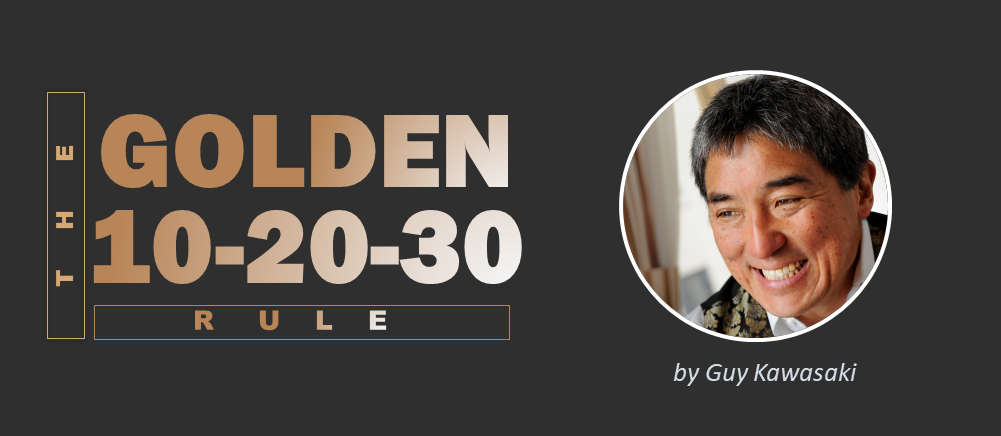We all have faced the fear of public speaking at least once in our lifetime. Standing on the podium, in front of power-dressed men and women waiting to devour us as soon as we make a mistake with the only shield, our support system - the presentation that we have to spend hours and hours on getting perfected. Maybe compromising our sleep to get that one presentation right.
Trust me this feeling is mutual among all the newbies, entering into the world of public speaking and even for professionals sometimes. However, professionals know how to conquer this fear of theirs!
But many of us, even experts, get these presentations so wrong that instead of being a powerful persuasive tool they are nothing but a source of Death-By-PowerPoint. Learn how to avoid “death” with your PowerPoint slides by honing Guy Kawasaki’s 10-20-30 rule (as called by him).
Now, who is this Guy Kawasaki? And what is this 10-20-30 Rule?
Guy Kawasaki formerly an Apple employee, achieved an iconic status amongst other venture capitalists. Perhaps he is renowned not because he is a venture capitalist but because he was the leading thinker behind the famous 10-20-30 rule which was devised in the year 2005. Guy Kawasaki was the genius brain behind the rule that totally transformed PowerPoint presentations.
Now coming to the famous 10-20-30 rule for which you are here. In simplest of its form 10-20-30 rule stands for-
- Not more than 10 PowerPoint slides,
- Not more than 20 minutes,
- A minimum of 30 font size.
After listening to hundreds of PowerPoint presentations delivered by enthusiastic entrepreneurs, he evangelised this 10-20-30 rule which says “a presentation should have 10 PowerPoint slides, last no more than 20 minutes, and contain no font smaller than 30 pts”.
Such refined rules might be considered as a limitation by some people, especially those who have a habit of loading their slides with a lot of text. However, this 10-20-30 rule has been accepted as a blueprint to make effective PowerPoint presentations worldwide.
Now, let us dig deeper and explore this rule in detail-
Rule - 10 PowerPoint Slides
Reason - Enough to convey the actual message
In a nutshell, Guy Kawasaki says that 10 is the optimal number of slides that a presenter should add in the presentation. Instead of bombarding the audience with too many slides, one should keep the presentation short, crisp and to the point. Your audiences have no interest in details; so refrain yourself from giving them the minutia.
However, 10 slides doesn’t mean filling those slides with too much text. One should only add that text to the slides which convey the actual message.
Guy also says that these should be the 10 slides that a venture capitalist should add to his presentation-
- Title- Give a suitable title/ name to your presentation according to the topic.
- Problem/Opportunity: - Explain the pain you are mitigating or the opportunities you are providing.
- Value Proposition: - Explain the value of the pain you are mitigating or the value of what all opportunities you are providing. In other words, provide an apt solution to the problems.
- Underlying Magic: - This slide is all about the technology and the secret sauce behind your product. Use as little text in this slide as possible rather show your stats using charts and graphs.
- Business Plan: - Explain who owns your company’s money right now and how you are planning to acquire the same.
- Go to Market Plan: - Explain how your product will reach your customers and other masses without burning a hole in your pocket.
- Competitive Analysis: -Showcase the entire competitive landscape in this slide. Make it as detailed as possible.
- Management Team: - Portrait all the key members of your company such as investors, Board of Directors, and advisors. Don’t worry if your team is not perfect. You still have to mention all your team members with their names and designations.
- Financial Projections and Key Metrics: - Show a three year to five-year forecast consisting of not only dollars but also key metrics such as a number of customers, installation, licenses etc.
- Current Status, Accomplishments to Date, Timeline, and use of Funds: - Explain the current status of your product, show the accomplishments to date. Explain how the money will be used.
Note- You can alter and modify these points as per the need of your topic.
Download this Pitch Deck Template For Entrepreneurs Powerpoint Presentation Slides
Rule - 20 Minutes
Reason - The attention span of people is getting shorter and shorter
Martin Luther King needed only 17 minutes to share his dream with the world.
So why do you need more than 20 minutes? Even though sometimes you need more time to explain the topic to your audience.
According to Guy Kawasaki, decreased span of attention is the culprit. All thanks to television and mobile phones (they are certainly important), the span of attention is decreasing day by day. So one should be able to present his work in a 20-minute marathon which is indeed very challenging to run but guarantees 100% success.
Guy also argues that sticking to a 20-minute speech will force the person to alter the content mercilessly. With a time constraint, the presenter will be able to trim all the unnecessary details thus helping him communicate with efficacy and precision.
A 20-minute presentation would allow the presenter to conduct a Question and Answer session for his audience in the end which is also very important as in most of the cases, the audience does have some questions to ask regarding the presentation.
Rule - 30 Font Size
Reason - Don’t force your audience to squint
Squinting might look good in pictures but not in a presentation hall. The last thing you want is to see your audience squint.
Smaller font size interferes with the readability and so your font size should not be less than 30 points.
Having a font size that is larger will force the presenter to choose his words judiciously and also will make it much easier for the audience to read what is written in the slides. Since the font is readable to all the audience whether they are sitting in the front or back, they will pay more attention to what is being said by the speaker rather than what is being shown in the PowerPoint slides.
Applying this rule is easier said than done!
However, here are a few power-packed examples of speeches that have beautifully incorporated the rule of presenting more in less time-
Some examples of power-packed speeches
You must have seen or heard at least one of the universally acclaimed TED Talks which shook the world with their presentation skills, in a limited time period. Here are four of them which I would especially recommend you to watch if you haven’t.
Sir Ken Robinson’s - “How schools are killing creativity”
Duration- 19:25
Being one of the most popular and most viewed TED Talk, Sir Ken Robinson forces one to think about education differently. He says that instead of emphasising on standardized testing schools should nurture curiosity among its students.
In his talk, Ken criticizes the education system in American schools for instilling in its students, conformity rather than creativity from a very young age.
Julian Treasure- “How to Speak so that people want to Listen”
Duration- 9:58
Have you ever experienced that you are busy talking but nobody is listening? Perhaps you are a teacher! Well, this happens a lot of time with a teacher or a lecturer.
Here’s Julian Treasure’s awe-inspiring talk that demonstrates the do’s and don'ts of public speaking backed up with empathy as well as some handy vocal exercises. This talk is surely an example of how a big idea can be conveyed in a short duration as less as 10 minutes helping the world sound beautiful.
Dan Pink- “The Puzzle of Motivation”
Duration- 18:36
In his powerful talk of 18 minutes, Dan Pink scrutinizes the efficacy of punishment as well as rewards given in the workplace. And the results are indeed very surprising.
Differentiating between the two sets of motivators- intrinsic and extrinsic and the various types of rewards, Dan Pink reveals why there is a need to rethink about running our businesses differently. He also explains how the leaders can motivate us to carry the various activities in our business in a different manner.
TED Talks is not only limited to these three talks; rather it treasures hundreds of inspiring and motivating speeches that one must see. These were just a few examples that we have shared with you to make you understand that you don’t need hours and hours to convey your message. 20 minutes is more than enough to get your message out there!
If you are thinking of downloading some pre-designed PowerPoint templates for assistance. Here are a few examples-
Download 10-20-30 Rule Templates
Download this New Product Overview PowerPoint Presentation Slides
Grab this Systems Design PowerPoint Presentation Slides
Click here to download this Expertise Matrix PowerPoint Presentation Slides
PowerPoint Template 4:
Access this Exigency Plan Powerpoint Presentation Slides
So, there you have it, a dynamic tool to transform your presentations. Apply this 10-20-30 rule and let your presentation be a breath of fresh air for all your audiences.





 Customer Reviews
Customer Reviews






















